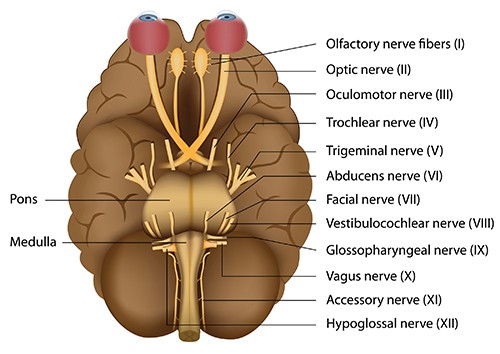Hone Your Skills in Cranial Nerve Assessment
Margaret A. Fitzgerald, DNP, FNP-BC, NP-C, FAANP, CSP, FAAN, DCC, FNAP
I am concerned about the portion of the NP certification examination that will address detailed assessment of the neurological system, particularly the cranial nerves. What’s the best way to study this material?
As you prepare for your certification exam, make sure you take a close look at the information your certifying agency provides about the test’s content. Well-honed physical assessment skills are important to safe, competent, entry-level NP practice, and the certification exams reflect this by dedicating a significant portion of each test to this area.
Many certification exam candidates feel quite confident of physical assessment skills they have used often in RN practice, such as evaluation of the respiratory or cardiac systems. Other areas, such as detailed assessment of the neurological system, have not been as well developed.
This Q&A presents information and practice questions to use in honing your neurological assessment skills, particularly in assessing the cranial nerves.

Cranial Nerve Mnemonic
A commonly used mnemonic for identifying and remembering the cranial nerves is: On Old Olympus’ Towering Tops, A Finn And German Viewed Some Hops. The details of the cranial nerves are as follows:
- CN I–Olfactory: You have one nose, which is where CN I resides. Its function contributes to the sense of smell.
- CN II–Optic: You have two eyes, where you will find CN II. The function of this cranial nerve is vital to vision and visual fields, and, in conjunction with CN III, pupillary reaction.
- CN III–Oculomotor: CN III, the eye (oculo-) movement (motor) nerve works with CN III, IV, and VI (abducens, which helps the eyeball abduct or move). The actions of these cranial nerves are largely responsible for the movement of the eyeball and eyelid.
- CN IV–Trochlear.
- CN V–Trigeminal: Three (tri) types of sensation—temperature, pain, and tactile—come from this three (tri)-branched nerve that covers three (tri) territories of the face. For normal corneal reflexes to be present, the afferent limb of the first division of CN V and the efferent limb of CN VII need to be intact.
- CN VI–Abducens.
- CN VII–Facial: Dysfunction of this nerve gives the characteristic findings of Bell’s palsy (facial asymmetry, mouth droop, flattened nasolabial fold, impaired eyelid movement).
- CN VIII–Auditory or vestibulocochlear: When this does not function properly, hearing (auditory) or balance is impaired (vestibulocochlear). The Rinne test is part of the evaluation of this cranial nerve.
- CN IX–Glossopharyngeal: The name of this cranial nerve provides a clue that its function affects the tongue (glosso) and throat (pharynx). Along with CN X, functioning of this nerve is critical to swallowing, palate elevation, and gustation.
- CN X–Vagus.
- CN XI–Accessory or spinal root of the accessory: The functioning of this cranial nerve can be tested by evaluating shoulder shrug and lateral neck rotation.
- CN XII–Hypoglossal: Function of this cranial nerve is tested by noting movement and protrusion of the tongue.
On Old Olympus’ Towering Tops,
A Finn And German Viewed
Some Hops
Putting Your Knowledge to the Test
Now try these sample questions that you might find on a certification exam.
- Pupillary response to light is, in part, a function of cranial nerves:
A. I and II C. III and IV B. II and III D. IV and V - You ask a patient to shrug her shoulders. This is, in part, an evaluation of cranial nerve:
A. V C. IX B. VII D. XI - The Rinne test is an important component of the evaluation of cranial nerve:
A. V C. VII B. VI D. VIII - Proper function of which of the following cranial nerves is needed for intact corneal reflexes?
A. IV C. VI B. V D. VIII - You ask a patient to open his mouth wide and say “Ahh.” If the soft palate rises asymmetrically, this can represent dysfunction of cranial nerves:
A. V and VI C. IX and X B. VII and VIII D. XI and XII
Successfully passing your certification exam marks a critical rite of passage and provides tangible evidence of your considerable achievement. Make sure you do everything possible to maximize your likelihood of success.